- Tyre Materials Conference 2025
- Tom Thomas
- Eonix Management Solutions
- Srikanth Chakravarthy
- HF Group
- Anil Nair
- Hasteri
- Dr Saikat Das Gupta
A Spectacle Of Excellence And Innovation Dazzles TMC 2025
- By Gaurav Nandi
- September 02, 2025

The Tyre Materials Conference 2025 unfolded as a high-octane showcase of innovation, urgency and collaboration amid the industry’s accelerating shift towards sustainability. With participation from global leaders, researchers and policymakers, the event addressed the fundamental transformation of tyre materials, from raw rubber to recycled steel and from EV-ready compounds to AI-powered sorting systems. Yet, beneath the applause and optimism lay sobering truths like systemic supply chain disruptions, regulatory uncertainty and the technological gap in scalable green alternatives. India’s growing ambition, collaborative initiatives and research strength emerged as hopeful beacons in a sector still grappling with fragmented standards and circularity bottlenecks.
A banquet hall in a posh New-Delhi hotel turned into an intellectual crucible to host a spectacle that drew in participants from different corners of the world for defining the future of the global tyre material industry.
As the emcee announced the commencement of the Tyre Materials Conference 2025 (TMC 2025), organised by Tyre Trends, applause rippled through the room, momentarily shaking the circular tables and rows of chairs that seated over 100 participants, each with eager eyes, ready to unwrap the future.
The hall gradually turned into a melting pot of ideas, innovation and future trends as the day unfolded. The spirit of excellence and innovation reverberated through the entire establishment with such grandeur that even outsiders wanted a peek inside.
Following the inaugural lamp lighting by Conference Chairman Tom Thomas and others, the stage was now set for insightful speeches and interactive sessions that encompassed everything from development of sustainable materials for the tyre industry to a panel discussion discussing the trends within the tyre materials sector.
 “The theme of this year’s conference that hinges upon raw material of tyres for future mobility could not be timelier. This conversation comes at a pivotal moment for our industry as we face a new generation of challenges and opportunities. There is a growing and urgent push for sustainability across the value chain. As an industry, we must reduce our dependence on petroleum-based raw materials, which currently make up nearly 55–60 percent of the material mix used by tyre manufacturers,” said Thomas in his inaugural address.
“The theme of this year’s conference that hinges upon raw material of tyres for future mobility could not be timelier. This conversation comes at a pivotal moment for our industry as we face a new generation of challenges and opportunities. There is a growing and urgent push for sustainability across the value chain. As an industry, we must reduce our dependence on petroleum-based raw materials, which currently make up nearly 55–60 percent of the material mix used by tyre manufacturers,” said Thomas in his inaugural address.
“Today, we are writing the next chapter of tyre material science – one that achieves sustainability without sacrificing performance, embraces innovation without compromising reliability and drives technological advancement while protecting our environment,” he added.
Highlighting the importance of collective collaboration in driving the industry forward during a special address, Eonix Management Solutions Managing Director Srikanth Chakravarthy said, “The future should be something we don’t fear and something that excites us. With Zenith Group, we’re not just talking about another supplier but about the world’s largest steel cord maker in the making, backed by USD 2 billion in investment, a USD 30 billion parent and the industry’s most advanced solar-powered, automated plant.
It’s the only company tracking carbon emissions in real time and targeting 100 percent recycled steel by 2027. As India’s steel cord demand doubles, Zenith plans to support with imports, warehousing and eventually local manufacturing. Collaboration across suppliers, competitors and customers is essential to create lasting value for our industry.”
Speaking at the conference, HF Group Business Development Director Anil Nair delivered a sharp, data-driven keynote outlining the structural and technological turbulence reshaping the global tyre industry. From volatile raw material costs to rising demands for electric vehicle-ready compounds, he painted a picture of an industry at a critical inflection point.
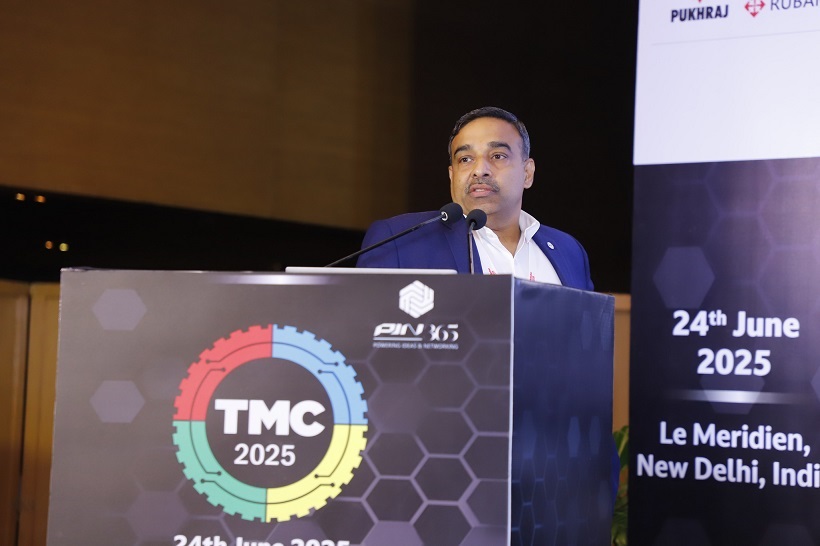 “Challenges are mounting across regions. Europe leads in sustainability regulation with the push for digital tyre passports, while US buyers remain cost-focused. In Asia, Japan and Korea prioritise performance even as China leans into price efficiency. Globally, manufacturers are grappling with premature crosslinking, high-silica formulations that undermine shelf life and erratic compound quality, especially when integrating bio-oils and recovered carbon black,” Nair explained.
“Challenges are mounting across regions. Europe leads in sustainability regulation with the push for digital tyre passports, while US buyers remain cost-focused. In Asia, Japan and Korea prioritise performance even as China leans into price efficiency. Globally, manufacturers are grappling with premature crosslinking, high-silica formulations that undermine shelf life and erratic compound quality, especially when integrating bio-oils and recovered carbon black,” Nair explained.
He noted that artificial intelligence emerges as a vital tool amid production shifts as tyre majors relocate factories to cheaper regions, triggering expertise gaps and costly closures. Nair emphasised that artificial intelligence can bridge generational knowledge loss by codifying best practices from veteran staff.
On the innovation front, he spotlighted smart tyres with real-time monitoring capabilities and self-adjusting pressure systems. He also stressed recyclability by design with tyres engineered for chemical disassembly and multi-cycle retreading. For EVs, the shift is clear, which includes quieter, lighter and longer-lasting tyres built around high-silica and nano-enhanced fillers.
Nair concluded with a call to rethink longevity, promoting materials that resist ageing, disperse uniformly and maintain performance across diverse geographies.
“This isn’t just evolution – it’s re-engineering the tyre from the molecule up,” Nair declared.
EMERGING MATERIALS
The tyre industry is embracing a sustainability revolution driven by regulation, innovation and performance demands. From circular economy models and advanced bead wire solutions to breakthrough chemical additives and EV-optimised rubber compounds, manufacturers are reshaping production to deliver high-efficiency, eco-conscious tyres fit for the future of mobility.
Speaking at the conference on sustainable materials, Hasteri Chief Scientist explained, “The global tyre industry is undergoing a profound transformation driven by increasingly stringent regulations and a commitment to sustainability. No longer a mere buzzword, sustainability is now central to manufacturing, encompassing economic, social and environmental considerations.”
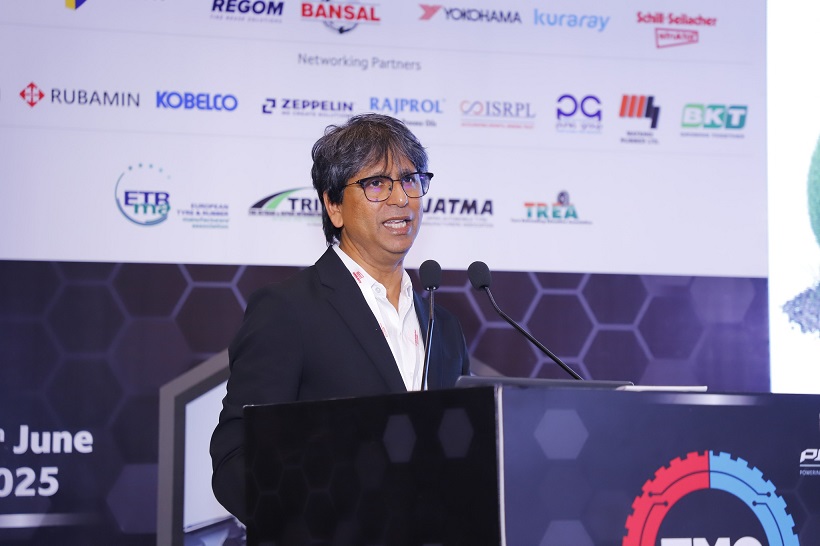 “This shift is seeing a move from a linear ‘use and throw’ model to a circular economy with significant investment in bio-based materials, advanced recycling of end-of-life tyres and decarbonisation efforts across the supply chain. New regulations including extended producer responsibility and limits on tyre wear particles are accelerating this change. With the market for sustainable tyre materials projected to see over 26 percent growth by 2029, the sector is embracing innovation, from bio-sourced rubbers and recycled steel to energy-efficient production, aiming for a future where tyres are both high-performing and environmentally responsible,” he added.
“This shift is seeing a move from a linear ‘use and throw’ model to a circular economy with significant investment in bio-based materials, advanced recycling of end-of-life tyres and decarbonisation efforts across the supply chain. New regulations including extended producer responsibility and limits on tyre wear particles are accelerating this change. With the market for sustainable tyre materials projected to see over 26 percent growth by 2029, the sector is embracing innovation, from bio-sourced rubbers and recycled steel to energy-efficient production, aiming for a future where tyres are both high-performing and environmentally responsible,” he added.
Drawing from nine real-world defect cases, Sun Hong Kim, Technical Head of Tyre Bead Wire Division at Bansal Wire Industries, outlined how bead wire stiffness and mechanical behaviour critically affect tyre beading performance.
He noted that stiffness, regulated by the take-off machine’s killing roller, determines how the wire responds under load. “Low stiffness wires deform more easily, while high stiffness variants resist structural failure. Defects such as wire lift-up, bending, tilting and S-type straightness are linked to mismatched stiffness, over- or under-killing, reduced yield points and inconsistent brake tension during payoff,” explained Kim.
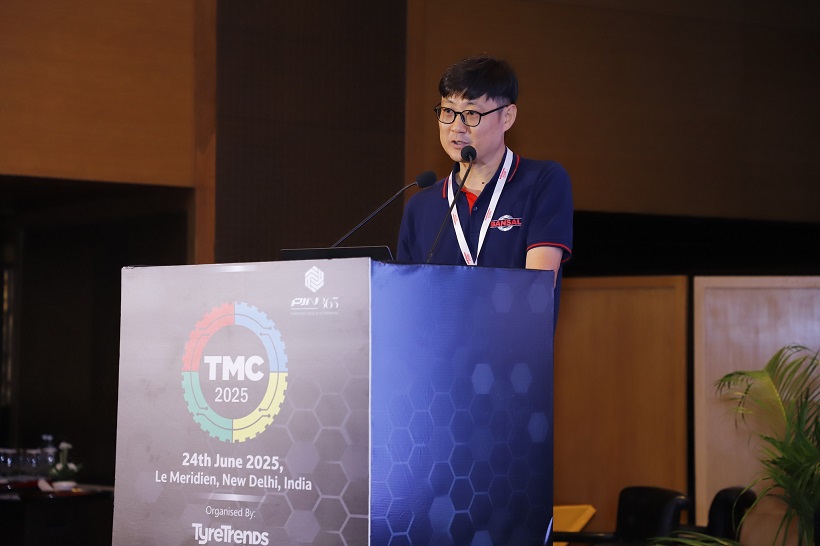 Furthermore, Kim pointed out that one recurring issue, namely fluctuating brake pressure, was resolved by installing an air regulator, highlighting the role of stable mechanical inputs.
Furthermore, Kim pointed out that one recurring issue, namely fluctuating brake pressure, was resolved by installing an air regulator, highlighting the role of stable mechanical inputs.
He also categorised defects into four types (A–D), each requiring specific interventions ranging from stiffness adjustment to wire straightening control. As tyre manufacturers demand higher consistency, his data-led approach offers a template for addressing bead wire variability across global production environments.
Leading chemical firm Schill + Seilacher “Struktol” is pioneering significant advancements in tyre manufacturing through its innovative additive, BP 19797, designed to enhance both production efficiency and product performance.
Speaking remotely at the conference, the company’s Senior Technical Sales Manager, Robert Kobel-Bryk, detailed how this new process promoter drastically improves silica dispersion in rubber compounds, enabling faster mixing cycles and a notable reduction in energy consumption during the manufacturing process. This translates directly into more efficient operations and a smaller carbon footprint.
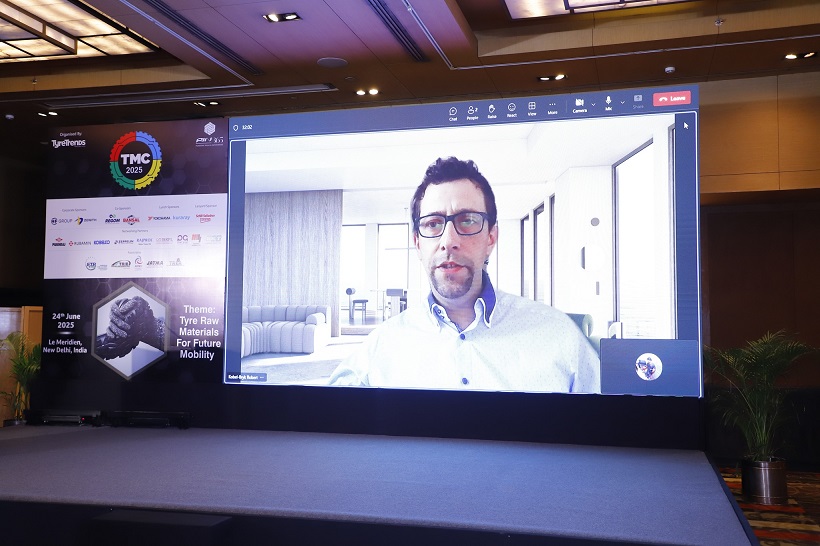 “BP 19797 yields superior extrusion properties and smoother surfaces for tyre components, leading to lower scrap rates. The introduction of this additive maintains or even minimally enhances the final physical properties of the tyre including tensile strength while concurrently improving the complex balance between wet grip and rolling resistance,” said Kobel-Bryk.
“BP 19797 yields superior extrusion properties and smoother surfaces for tyre components, leading to lower scrap rates. The introduction of this additive maintains or even minimally enhances the final physical properties of the tyre including tensile strength while concurrently improving the complex balance between wet grip and rolling resistance,” said Kobel-Bryk.
The company emphasises these developments as key to addressing industry demands for cleaner, safer and more efficient production methods.
Japanese speciality chemical firm Kuraray’s Technical Service Engineer at Elastomer Division, Naoto Takahashi, highlighted the company’s nearly 100-year history and detailed how its unique low-molecular-weight rubber acts as a reactive plasticiser, preventing bleed-out by co-vulcanising with base rubber.
“GS-L-BR significantly enhances crucial EV tyre properties including high wear resistance for heavy, high-torque vehicles and low rolling resistance for extended range and energy efficiency. Our novel approach for tyre treads involves increasing natural rubber content, a combination traditionally challenged by filler interaction. GS-L-BR overcomes this by improving the bond between natural rubber and silica, outperforming conventional formulations in wear and rolling resistance while also boosting wet grip,” contended Takahashi.
He added, “For sidewalls, replacing carbon black with silica becomes viable as GS-L-BR dramatically improves fatigue resistance. This groundbreaking material promises to be a key component for the next generation of EV and even commercial vehicle tyres, addressing critical performance and sustainability needs.”
GOING GREEN
The tyre industry is undergoing a technological shift for going green with innovations in recycling, advanced materials and processing systems. From AI-driven sorting of end-of-life tyres to self-healing elastomers and high-silica mixing technologies, these breakthroughs are driving greater efficiency, sustainability and performance across the entire value chain.
Speaking at the conference, Senior Manager of Process Technology (Asian Countries and Global) at HF Group, Dr M N Aji, emphasised the critical role of combining machinery and processing expertise for optimal silica mixing, especially as silica usage in tyre technology is rapidly increasing with some applications reaching up to 160 parts-per-hundred-rubber (PHR).
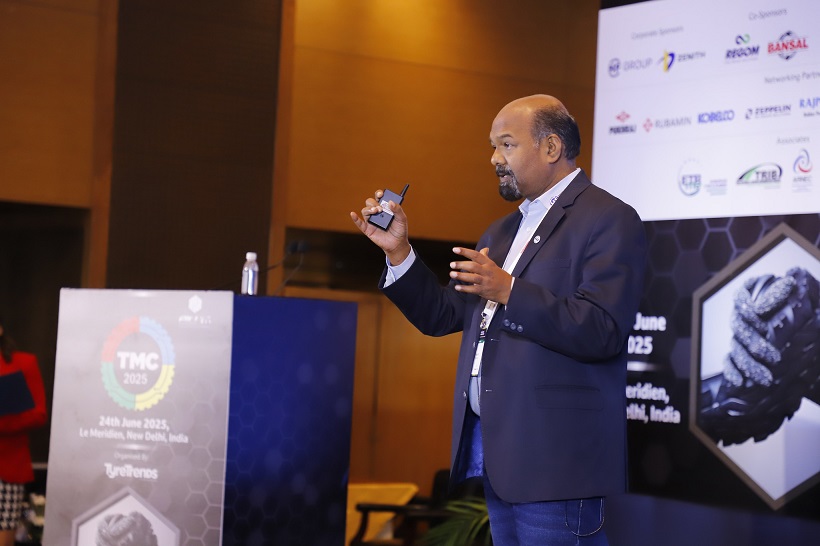 “Incorporating high levels of silica with specialised polymers is crucial to achieve superior properties like better mileage, lower noise levels and improved traction. HF Group’s innovative mixer technologies including tangential (Z4 rotor) and intermeshing (PS7/PS5 rotor) designs offer enhanced shear, cooling efficiency and intake. The Z4 rotor’s versatility for both silica and final batch mixing is noted along with the development of new wear-resistant materials (HFSI 50) and intelligent ram technology (i-EXL) for energy and cost savings,” averred Aji.
“Incorporating high levels of silica with specialised polymers is crucial to achieve superior properties like better mileage, lower noise levels and improved traction. HF Group’s innovative mixer technologies including tangential (Z4 rotor) and intermeshing (PS7/PS5 rotor) designs offer enhanced shear, cooling efficiency and intake. The Z4 rotor’s versatility for both silica and final batch mixing is noted along with the development of new wear-resistant materials (HFSI 50) and intelligent ram technology (i-EXL) for energy and cost savings,” averred Aji.
He added that key to successful silica mixing were precise temperature control, viscosity reduction and excellent dispersion. The importance of maintaining optimal water quality for cooling and adhering to strict acid cleaning schedules for mixer maintenance is imperative.
“Tandem mixing technology was introduced as a cutting-edge solution for high-fill silica masterbatches, offering 100 percent productivity and superior temperature control by separating dispersion and distribution processes. HF Group’s TRC co-axial rotor technology was specifically designed for ultra-high silica content, ensuring better material cohesion and quality,” noted Aji.
Dr Shib Shankar Banerjee, Assistant Professor from IIT Delhi’s Department of Material Science and Engineering, presented cutting-edge research in polymer and elastomer materials, focusing on ‘new generation elastomeric materials’ that transcend conventional rubber properties. These materials aim for enhanced performance, functionality and processability, incorporating features like shape memory, self-healing, conductivity and magnetic properties.
One key area of research involved thermoplastic elastomers with improved phase compatibility and self-healing capabilities, particularly leveraging shape memory assistance to repair micro-cracks.
Dr Banerjee noted that his team is also exploring 3D printing of rubber-like materials for complex geometries and developing soft and multi-functional materials using liquid metals (Gallium and eutectic Gallium-Indium alloy) to create conductive, magnetic, yet soft elastomers for flexible and stretchable electronics.
A significant portion of his presentation was dedicated to the development of hydrogenated SBR (HSBR) based vulcanisates with superior traction performance, a collaborative effort with Hasetri. HSBR exhibits a more homogeneous network structure, leading to better ageing resistance, higher modulus at elongation, improved wet and dry traction, better rolling resistance and enhanced abrasion and fatigue properties compared to conventional SBR.
His research also explored the synergistic effect of hybrid fillers like CNT in HSBR, noting improved filler dispersion due to higher viscosity and styrene content.
Innovating tyre recycling with smart sorting technology, France-based Regom’s Chief Executive Officer, Arthur Wagner, introduced his company’s innovative approach to maximising the value of end-of-life tyres through advanced sorting. Recognising the challenges of manual sorting and the lack of data in the used tyre industry, Wagner stated, “Our core innovation is a machine that processes tyres individually, capturing images and using artificial intelligence to analyse brand, model, dimensions, load and speed indices and DOT codes in less than a second. This system, refined over six years with a vast database from processing over 20 million tyres annually, can operate efficiently even with wet or muddy tyres.”
He went on to say that the system allows customers to configure custom rejection criteria, automatically diverting tyres with no value to shredding and streamlining manual grading for valuable tyres. This automation significantly increases resale prices, optimises retreading and enhances material recovery, while also reducing labour pain points and costs.
A key application of Regom’s technology is in pyrolysis, where precise sorting of tyres helps maximise the quality of the output. The company is also at the forefront of integrating RFID technology into tyre sorting.
MARKET ECONOMICS
Natural rubber remains vital to the global tyre industry, yet its supply chain faces mounting pressures from climate change, labour shortages, regulatory shifts and price volatility. As demand grows, industry stakeholders are exploring innovation, sustainability and traceability to secure long-term supply and meet ambitious environmental goals.
Explaining the volatile raw material landscape, Yokohama Off Highway Tires Chief Sustainability Officer Padmakumar G said, “Change is the predominant challenge in the tyre industry’s raw material supply chain. Current volatility stems from several factors, which include the EU Deforestation Regulation causing natural rubber price and availability issues, Indian import restrictions impacting steel and unpredictable crude oil prices affecting petrochemical-derived materials like carbon black and synthetic rubber.”
“Global shipping faces constant disruptions from Suez Canal blockages to geo-political conflicts forcing longer, costlier routes. Even evolving trade policies such as new US-Mexico green corridors demand continuous vigilance. Looking ahead, the industry’s ambitious 2050 sustainability goals present formidable challenges. Shifting to 100 percent sustainable raw materials necessitates developing bio-based alternatives for carbon black, synthetic rubber, and fabrics, which is a significant hurdle given current technological limitations and lack of mass production,” he added.
He asserted that India’s ingenuity will be crucial in overcoming these profound material and supply chain transformations, ensuring the industry’s future viability amidst relentless change.
Alluding to the global natural rubber landscape ANRPC Senior Economist Dr Lekshmi Nair said, “Natural rubber (NR) is a crucial strategic raw material with use in diverse applications beyond tyres, though the tyre industry accounts for 70 percent of its global consumption. A significant challenge stems from the fact that approximately 90 percent of global NR production originates from small growers in tropical regions. These farmers face issues such as low productivity, limited access to resources, volatile prices and the changing demographics as younger generations are less interested in labour-intensive rubber tapping. The lengthy 30-year lifecycle of rubber trees including a six-year immaturity period also deters investment and quick innovation adoption.”
She noted that globally, Thailand, Indonesia and Ivory Coast are the largest NR producers, contributing around 65 percent of the world’s supply, with Vietnam emerging as the fourth. Historically, Asian producers accounted for 91-92 percent of global production, but this has decreased to 79 percent, while West Africa, particularly Ivory Coast, has seen its share rise to 21 percent.
Consumption patterns have also shifted with 67 percent of NR usage now in Asian countries like China, India and Thailand. Despite a projected deficit of 0.7 million tonnes (demand of 15.5 million tonnes versus supply of 14.8 million tonnes), price volatility is often driven by speculative factors rather than market fundamentals, partly due to low investment in replanting.
A key regulatory challenge is the EU Deforestation Regulation, which came into force in June 2023. Compliance for large and medium-sized operators is required by 31 December 2025 and for micro and small enterprises by 30 June 2026. This regulation demands full traceability to prove that NR and products containing it are not sourced from land deforested or degraded after 31 December 2020. While NR is inherently sustainable, this regulation complicates supply chains, especially for producers exporting to Europe, which accounts for 12 percent of total NR consumption in its final products.
“Initiatives like the Global Platform for Sustainable Natural Rubber are working on common guidelines, traceability programmes and capacity building to help the entire value chain, including smallholders, adapt to these new demands. Collaboration and policy support are will be essential for successful implementation of these sustainable transitions and for navigating price volatility, climate change impacts and evolving trade policies,” contended Nair.
THE PANEL
The panel discussion on ‘Emerging Scenarios of Tyre Materials’ brought together leading minds from India’s tyre industry to dissect the monumental shift towards sustainability. It featured CEAT Vice President of Research and Development (Centre of Excellence), Sujith Nair; Yokohama-ATG Head – Corporate Research and Development (Materials and Compounding), C Harimohan; Apollo Tyres’ Divisional Head Raw Material Development, Rajitha R and Ralson Tyres Chief Technology Officer Vidit Jain. The panel was moderated by Eonix Management Solutions Managing Director Srikanth Chakravarthy.
Chakravarthy opened the session by highlighting the immense scale of the transformation ahead. Citing projections of a five to six-fold growth in tyre production and a shift from 35 percent to 100 percent sustainable materials within 25 years, he posed the fundamental question: How is the Indian tyre industry preparing for this paradigm shift, particularly concerning the move away from petroleum-based materials like synthetic rubber and carbon black?
Nair outlined the industry’s approach in three key phases, namely sustainable and green materials with a focus on environmentally friendly and SoC-free options; reduce, recycle and reuse, aiming to lessen tyre weight, reduce carbon dioxide emissions and minimise material wear, encompassing practices like retreading and renewal and sustainable sourcing, exploring new and responsible ways to procure raw materials.
Nair underscored the excitement around green materials, particularly natural alternatives, despite inherent challenges in development and application and highlighted the push for recycled materials with a focus on enhancing the strength of high-tensile materials for use in compounds. The scaling up of new materials, maintaining quality and navigating diverse specifications and certifications across factories present significant hurdles.
Harimohan reinforced Nair’s points, stressing the importance of a holistic understanding of sustainability. He narrowed the focus to the six material types that constitute 85-88 percent of total raw material consumption in tyre manufacturing, namely natural rubber, synthetic rubber, carbon black, steel cord, textiles and rubber process oil.
While natural rubber is largely considered a sustainable material, Harimohan identified synthetic rubber and carbon black as the two areas requiring breakthroughs. He noted that bio-sourced butadiene (for synthetic rubber) is technologically proven with pilot plants in operation and collaborations underway such as Michelin’s European partnerships and Yokohama’s collaboration with a Japanese synthetic rubber company.
The challenge, however, lies in the circularity of carbon black. Harimohan explained that recovered carbon black currently acts more as a filler than a direct replacement for virgin carbon black due to significant degradation during pyrolysis.
He advocated for research to improve the properties of recovered carbon black to 80-90 percent of its original capabilities. Similarly, he called for advancements in recycled rubber, which currently retains only 5-6 MPA of tensile strength compared to 20-25 MPA for virgin compounds.
Recognising the shared nature of the sustainability challenge, the discussion turned to the need for greater collaboration within the industry. Nair revealed that the Indian Tyre Technical Advisory Committee (ITTAC) has already initiated a consortium of tyre companies to work with raw material manufacturers on developing common specifications.
Three such projects primarily focused on sustainable IT space, pyrolysis of carbon black and reclaim rubber are underway. Nair emphasised the necessity of expanding these efforts, citing examples like the European tyre industry’s consortiums.
He also called for greater investment in research and development centres across all tyre companies as a foundational step for effective collaboration and advocated for partnerships with academic institutes.
Rajitha introduced a sobering data point, which stated that in the last 50 years, no new major entrant has emerged in the global tyre industry, while some established players have diminished. She highlighted the immense potential of large Indian conglomerates like the Reliance Group, who are already involved in many tyre-related products to drive significant breakthroughs.
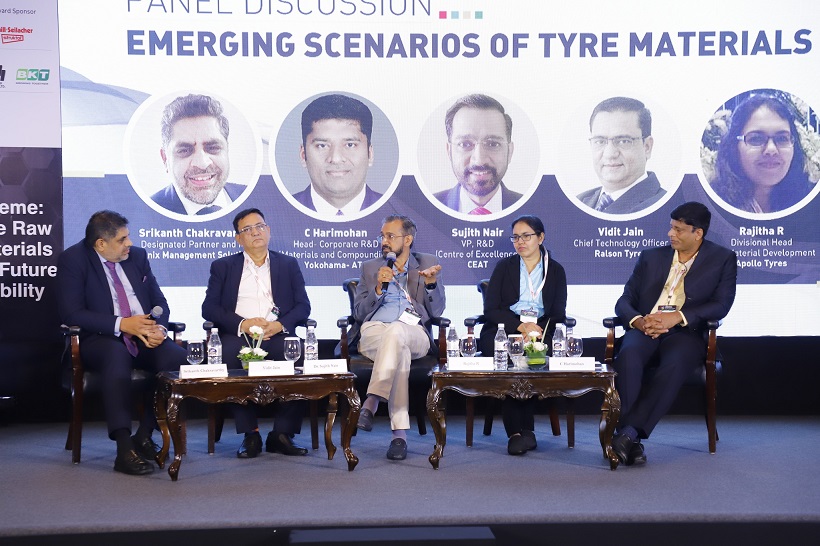 The panel unanimously agreed that achieving sustainability goals requires a holistic approach, encompassing the entire supply chain. Rajitha underlined the importance of selecting suppliers with strong research and development capabilities and a quick adaptability to new technologies, also stressing the need for local partners to meet global standards.
The panel unanimously agreed that achieving sustainability goals requires a holistic approach, encompassing the entire supply chain. Rajitha underlined the importance of selecting suppliers with strong research and development capabilities and a quick adaptability to new technologies, also stressing the need for local partners to meet global standards.
A key challenge raised by the moderator was the often-lengthy tyre approval process, especially when introducing entirely new materials. Rajitha acknowledged that validation processes would need to evolve.
She suggested that validation time could be minimised when new materials maintain similar basic molecular structures and properties and highlighted the increasing use of virtual and physical simulations and advanced ageing testing to expedite validation.
The standardisation of recycled materials like recovered carbon black with established specifications could also significantly streamline the process. Nair added that while striving for 100 percent performance equivalence when replacing virgin materials is ideal, a pragmatic approach might involve accepting 85-90 percent and then compensating through redesign.
Industry leaders from CEAT, Yokohama-ATG, Apollo Tyres, and Ralson Tyres engage in a dynamic panel on ‘Emerging Scenarios of Tyre Materials,’ moderated by Srikanth Chakravarthy.
He introduced a fourth ‘R’, calling it ‘redesign’, as a faster approach to validation. The potential of artificial intelligence and its integration with simulation models to accelerate the decision-making process for new materials was also briefly touched upon with the consensus that this is indeed the way to go.
The panel discussion underscored the Indian tyre industry’s earnest efforts in navigating the complex landscape of sustainable materials. While challenges abound in material science, supply chain collaboration and regulatory alignment, the collective commitment to innovation and a greener future appears strong.
TMC 2025 made clear that the journey to sustainable tyre materials is as complex as it is critical. While innovation is abundant, real progress hinges on global cooperation, scalable technology and faster validation systems. The path ahead demands collective resolve to redesign not just materials but the very approach to tyre manufacturing.
The next edition will be held in 2027 on a bigger scale!

The rollout of GST 2.0 marks a defining moment in India’s economic journey – a reform that may well prove even more consequential than the original introduction of the Goods and Services Tax. Especially for a sector like tyres, the recent reduction in (GST) on tyres is far more than just a change in numbers. It is a transformative step that touches every wheel turning on India’s roads – from a farmer’s tractor to a trucker’s long-haul trailer and from a commuter’s scooter to a construction vehicle powering the nation’s infrastructure.
For years, tyres were taxed at 28 percent – the highest GST slab, clubbed with luxury and demerit goods. This categorisation never truly reflected the essential role tyres play in our everyday lives. Tyres are not a luxury. They are a fundamental enabler of mobility, supporting the movement of people and goods across cities, towns and villages. By bringing GST rates on tyres down to a more rational level, the government has addressed a long-standing anomaly and set the stage for widespread benefits across the economy.
The most visible impact of this move will be felt on the ground – literally. Lower GST means more affordable tyres for all users. Especially for transporters and fleet operators, tyres account for a significant chunk of vehicle running costs. A reduction in tax translates into lower replacement costs, freeing up working capital and improving operational margins. Farmers, small traders, delivery personnel, service providers, transporters – every segment that relies on mobility will feel this relief.
India has been working hard to bring down logistics costs, which are believed to be about 13–14 percent of GDP – much higher than global benchmarks. Tyres have a direct bearing on vehicle operating efficiency, fuel consumption and maintenance schedules. When tyres become more affordable, operators can replace tyres on time, and run vehicles more efficiently.
This naturally leads to lower logistics costs. Reduced logistics costs ripple across the value chain, helping industries move goods faster and at lower cost. This aligns perfectly with India’s ambition to become a more globally competitive manufacturing and trading hub.
Tyre industry’s story is not just urban – it’s deeply rural as well. Tractor tyres, power tiller tyres and tyres for animal-drawn vehicles are integral to the agricultural economy. A reduction in GST brings meaningful relief to farmers and small cultivators who rely on these tyres for their daily operations. By easing this cost, the government has extended direct support to rural mobility and agricultural productivity – an often underappreciated but critical outcome of this reform.
One of the most powerful yet often overlooked impacts of this decision lies in road safety. Worn-out tyres are a major cause of road accidents, particularly on highways. High replacement costs often lead to tyres being used well past their safe life.
With lower GST making new tyres more accessible, both individual motorists and commercial fleet owners are more likely to replace tyres on time, keeping vehicles safer and reducing accident risks. This complements the government’s broader road safety agenda, making highways not just faster but safer for everyone.
For the Indian tyre industry, which is one of the largest in the world, this reform is a game changer. It creates a more balanced tax structure, supports better cash flow, improves compliance and strengthens the competitiveness of domestic manufacturers. It will also encourage investment and capacity expansion, enabling the industry to serve growing domestic demand and tap export opportunities more effectively.
The GST reduction on tyres is a strategic, forward-looking policy decision that will benefit the entire mobility ecosystem. It acknowledges the essential role tyres play – not just as a product, but as a critical enabler of transportation, logistics, rural livelihoods and road safety.
As this reform takes root, its positive impact will be felt by consumers, businesses, farmers and industries alike. The tyre industry, represented by ATMA, welcomes this move wholeheartedly and remains committed to working alongside the government to strengthen India’s journey towards affordable, efficient and safe mobility for all.
The author is Director General of the New Delhi-based tyre industry association, Automotive Tyre Manufacturers’ Association (ATMA).The views expressed here are personal.
WACKER Secures Gold Medal In EcoVadis Sustainability Rating
- By TT News
- December 18, 2025

WACKER has earned the 2025 Gold Medal from the independent rating agency EcoVadis, marking its continued recognition for sustainable practices and responsible corporate governance. This distinction places the company within the top five percent of all businesses assessed by EcoVadis (over 1,000 companies globally). WACKER's overall score improved from 77 points (in 2024) to 79 points, driven largely by enhanced reporting and concrete actions focused on Scope 3 emissions and ethical standards.
The EcoVadis assessment measures the quality of a company’s sustainability management through a methodology grounded in international frameworks like the Global Reporting Initiative, the UN Global Compact and ISO 26000. Performance is scored from 0 to 100 across four core areas: environment, labour and human rights, ethics and sustainable procurement, using 21 specific indicators.
In line with its commitment, WACKER provides its EcoVadis evaluation to customers as a standardised and credible validation of its sustainability efforts. The company has also defined ambitious climate targets, aiming to halve its absolute greenhouse gas emissions by 2030 relative to 2020 levels. Progress is already evident, with a 30 percent reduction achieved as of 2024. Looking further ahead, WACKER strives to reach net-zero emissions across its operations by the year 2045.
Peter Gigler, Head of Corporate ESG, WACKER, said, “The result confirms our initiatives in many key areas. It provides our customers with invaluable proof.”
Craig Borman Appointed As Head Of OTR At BKT USA
- By TT News
- December 18, 2025

Balkrishna Industries Ltd (BKT Tires), a global leader in off-highway tyre manufacturing, has appointed Craig Borman as Head of OTR at BKT USA. The appointment is in line with BKT’s long-term strategy through 2030.
Borman brings with him 20 years of experience across off-road equipment, tyres and rubber tracks. He will play a key role in leading BKT USA's OTR team and expanding the company's presence in this market while increasing awareness of the value and dependability of BKT's range of products.
Borman said, “I’m extremely excited to join the BKT family and to build off the successes that this team has already achieved. I look forward to engaging with our partners, determining how we can accelerate our mutual growth and working towards achieving BKT’s vision of being a recognised leader in the OTR segment.”
Christian Kötz To Succeed Nikolai Setzer As Continental CEO In Planned Handover
- By TT News
- December 18, 2025

The Supervisory Board of Continental AG confirmed a significant leadership transition during its meeting on 17 December 2025. Christian Kötz will be appointed as the new Chairman of the Executive Board and Chief Executive Officer, effective 1 January 2026. He succeeds Nikolai Setzer, who will step down from the Executive Board on 31 December 2025. Setzer's departure follows more than 16 years as a board member, including the last five years in the CEO role, and occurs by mutual agreement as the company reaches a pivotal point in its strategic evolution.
This planned change in leadership aligns with the substantial progress Continental has made in its transformation into a pure-play tyre company. Major structural milestones have been achieved, including the spin-off of Aumovio and the signing of an agreement to sell the Original Equipment Solutions (OESL) business area. Regarding the planned 2026 sale of ContiTech, internal preparations are largely complete. The market outreach phase has concluded, and a structured sales process is scheduled to begin in January 2026, setting the stage for the final step in the corporate realignment.
Kötz’s extensive background within the tyre business, dating back to 1996, positions him to lead this final phase. A member of the Executive Board since 2019, his previous leadership roles within the Tires group sector included responsibility for the passenger car tyre replacement business in the EMEA region, the original equipment and commercial vehicle tyre business units and global research and development for passenger car tyres. His many years of trusted collaboration with Nikolai Setzer are expected to ensure continuity during the transition.
Kötz will lead an Executive Board comprising several key figures. Alongside him and Philip Nelles, who has headed the ContiTech group sector since 2021, are Roland Welzbacher and Ulrike Hintze. Welzbacher joined the board in August 2025 and assumed the role of Chief Financial Officer on 1 October 2025. Hintze was appointed to the board on 1 July 2025, serving as Chief Human Resources Officer and Director of Labour Relations. This board will be responsible for driving the tyre business forward, completing the corporate realignment and, following the sale of ContiTech, integrating the remaining group functions into the tyre organisation.
Wolfgang Reitzle, Chairman of Continental’s Supervisory Board, said, “Nikolai Setzer has been instrumental in shaping Continental, realigning the organisation and paving the way for three strong, independent companies. For this, he has the thanks of the entire Supervisory Board as well as my personal gratitude. With this handover, we are consolidating responsibility for the tyre business, the realignment and the remaining tasks of the group functions in one role. Christian Kötz is one of the most distinguished managers in the global tyre industry. With his extensive experience and passion for Continental, we firmly believe he is the right choice to lead the company successfully into the future.”
Setzer said, “In recent years, we have succeeded in transforming a diverse portfolio of businesses into three strong, independent champions. After 28 years at Continental, now is the right time for me to hand over responsibility to Christian Kötz. I’m extremely grateful for the journey we’ve all shared and proud of what we’ve all achieved together. I firmly believe that the tyre business, ContiTech, Aumovio and OESL have a promising future ahead.”
Kötz said, “I would like to thank the Supervisory Board for its trust and am excited about this new responsibility. Continental has been my professional home for three decades. Together with the Executive Board team and all colleagues throughout the company, we will complete the realignment and continue the success story of our tyre business.”







Comments (0)
ADD COMMENT